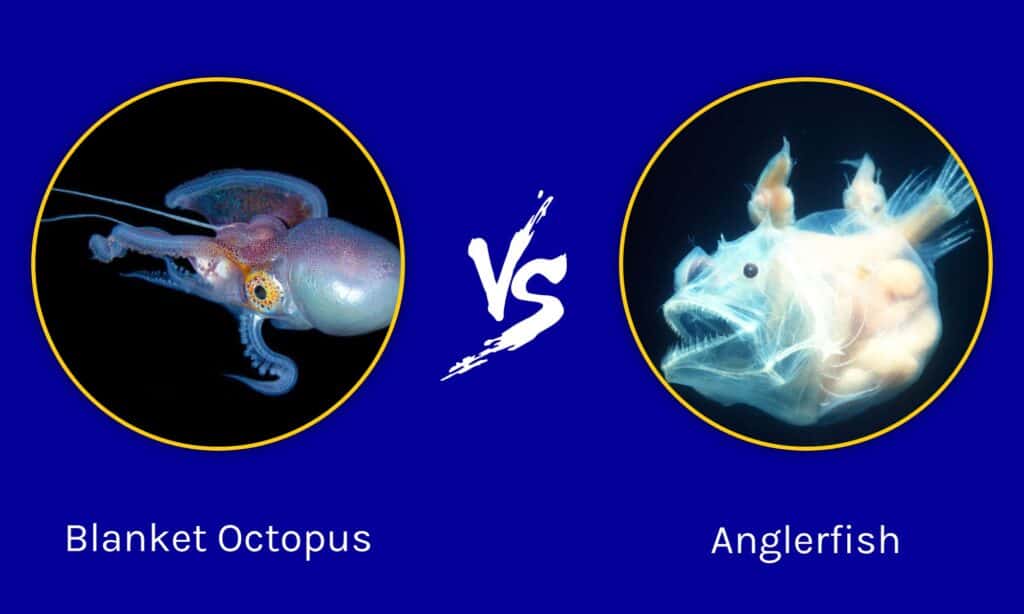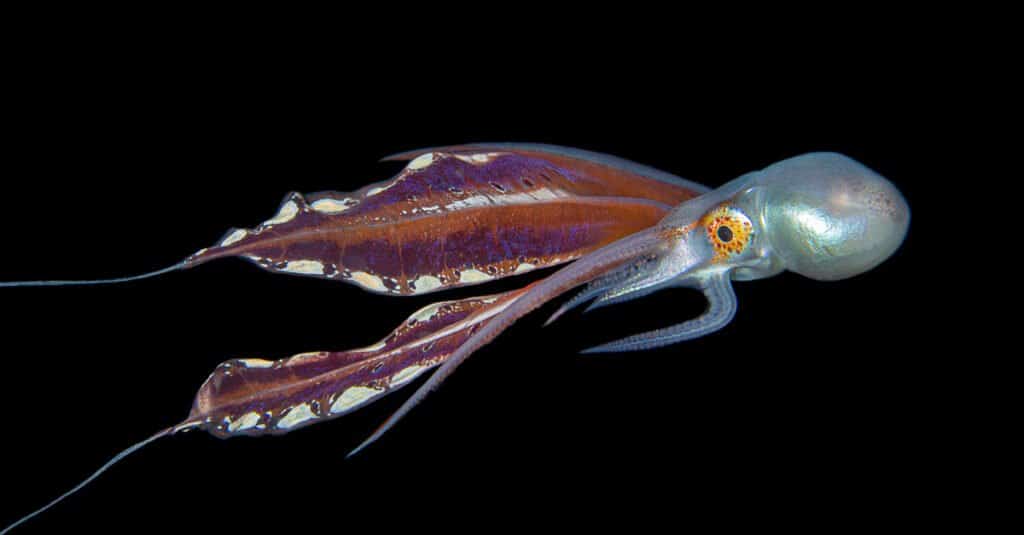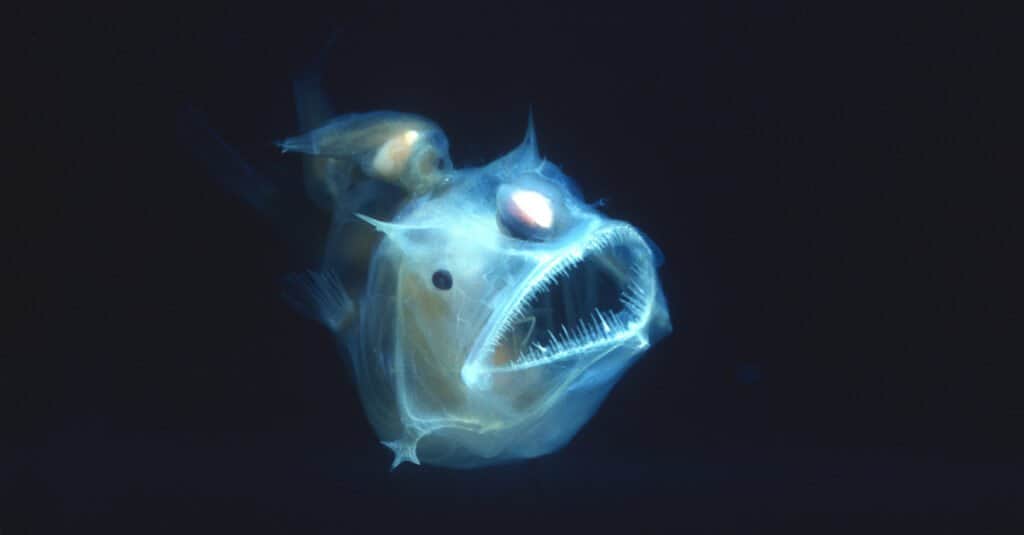The blanket octopus and anglerfish are marine animals that occupy subtropical and tropical oceans. The anglerfish has a reputation all to its own, but the blanket octopus is extremely rare and much less known. With a bizarre, silvery appearance and sharp fangs, most people often find the anglerfish scary. But while it could seem a little scary, it is just like any other animal.
This article explores the differences between a blanket octopus and an anglerfish and a bit more of what makes them unique. Blanket octopus vs anglerfish; why are they special?
Comparing Blanket Octopus vs Anglerfish

| Key Differences | Blanket Octopus | Anglerfish |
|---|---|---|
| Scientific classification | Kingdom- Animalia Phylum- Mollusca Class- Cephalopoda Order- Octopoda Family- Tremoctopodidae Genus-Tremoctopus | Kingdom- Animalia Phylum- Chordata Class- Actinopterygii Clade- Percomorpha Order- Lophiiformes |
| Color | Yellow, blue, red, orange, green, white, pink, purple | Yellow, gray, brown, green, black |
| Size | Weight: 6-10 lbs (Females), under an ounce (Males) Length: 3-6 feet (Females), whereas males are less than an inch | Weight: Up to 110 lbs Length: Up to 4 feet |
| Diet | Smaller fish | Crustaceans and fish |
| Habitat | From surface to mid-waters, a Coral reef | Bathypelagic zone of the open ocean |
| Reproduction | Is semelparous, meaning they die shortly after mating | The pair forms a close union together, though reproduction occurs via external fertilization |
| Human consumption | No human consumption | Famous as a winter delicacy in Japan |
| Lifespan | 4 years (Females), 1.5 years (Males) | Up to 25 years |
8 Key Differences Between a Blanket Octopus and an Anglerfish
The main difference between a blanket octopus and an anglerfish is that blanket octopuses are surface to mid-waters dwelling pelagic cephalopods, while anglerfishes are deepwater-dwelling apex predators. Other differences between the two are size, diet, habitat, reproduction, and lifespan.
Let’s look at all the differences between a blanket octopus and an anglerfish in a more detailed manner.
Blanket Octopus vs Anglerfish: Scientific Classification

The blanket octopus is a genus of pelagic cephalopods in the phylum
Molluscaand the family
Tremoctopodidae.
©Sam Robertshaw/Shutterstock.com
The blanket octopus is a genus of pelagic cephalopods, in the phylum Mollusca and the family Tremoctopodidae. It refers to four different species with unique skin webbing that connects their legs in a way that resembles a rainbow blanket. The four species are Tremoctopus violaceus, Tremoctopus gracilis, Tremoctopus gelatus, and Tremoctopus robsoni.
The anglerfish is an order of Lophiiformes named for its characteristic mode of predation, whereby its bioluminescent fin ray acts as a lure for other fish. There are approximately 200 documented species of anglerfish that are spread across eleven different families. Some of these species include monkfish, frogfish, and humpback anglerfish.
Blanket Octopus vs Anglerfish: Color
The blanket octopus appears in various colors, including yellow, blue, red, orange, green, white, pink, and purple. Like many other octopus species, blanket octopuses can change their patterns and coloration to blend with their environment.
The color of anglerfish typically ranges from dark gray to dark brown, but some are red, while others are green-yellow.
Blanket Octopus vs Anglerfish: Size

An adult anglerfish may weigh up to 110 pounds.
©Neil Bromhall/Shutterstock.com
The anglerfish is heavier than the blanket octopus. An adult anglerfish may weigh up to 110 pounds and measure up to 4 feet. However, male anglerfish are slightly smaller than females. Males only measure about an inch long.
On the contrary, the female blanket octopus weighs between 6 and 10 pounds and measures about 3 to 6 feet long, while males weigh under an ounce and are less than an inch long.
Blanket Octopus vs Anglerfish: Diet
Both species are carnivorous. However, the blanket octopus mainly feeds on smaller fish. It has one of the strangest methods of hunting prey. It uses its tentacles ripped from the toxic jellyfish to paralyze prey.
The diet of an anglerfish primarily consists of fish and crustaceans. Although the anglerfish can eat live prey, part of its diet consists of eating dead fish and other marine animals. The anglerfish’s jaw and stomach extend to allow it to consume prey twice its size. This adaptation also enables it to store enough food because of the limited amount of food available in its environment.
Blanket Octopus vs Anglerfish: Habitat

The blanket octopus occupies tropical and subtropical
oceans
.
©Sam Robertshaw/Shutterstock.com
The blanket octopus occupies tropical and subtropical oceans, living amongst the coral reefs. These graceful creatures are nomadic and keep moving from one location to another every couple of days since they can adapt to various water temperatures. The blanket octopus has been found in the Gulf of Mexico, the Australian Great Barrier Reef, the Indian Ocean, and the Mediterranean Sea.
Anglerfishes are very common in the murky depths of the Atlantic and Antarctic oceans. Although some anglerfish live in shallow, tropical environments, most live at depths of more than 6,000 feet, where sunlight is almost non-existent.
Blanket Octopus vs Anglerfish: Reproduction

The anglerfish has a very distinctive reproduction strategy.
©Neil Bromhall/Shutterstock.com
The mating process of blanket octopuses is deadly. Males have a modified large arm in a spherical pouch known as hectocotylus, used in mating. They detach this arm during mating and die shortly after. Females keep the arm in their mantle cavities until used for fertilization. The female carries over 100,000 eggs until they hatch. After hatching, she will most likely die as well.
The anglerfish has a very distinctive reproduction strategy. Males form tight bonds with females during mating. However, reproduction occurs via external fertilization. Females release the eggs into the water, while males release sperm, which locate and fertilize the eggs. After only a short union, the male is then free to reproduce again with another female.
Blanket Octopus vs Anglerfish: Human Consumption
Whales, blue sharks, and larger fish like tuna and billfish are among the few predators of blanket octopuses. Humans don’t consume these pelagic cephalopods. Unlike blanket octopuses, anglerfish is considered a delicacy in South Korea. The anglerfish is featured as the main ingredient in dishes like Agujjim.
Blanket Octopus vs Anglerfish: Lifespan
The average lifespan of blanket octopuses differs between sexes. Female blanket octopuses can live up to four years, while males live an average of 1.5 years, approximately a year or two. Unlike blanket octopuses, anglerfish can live up to 25 years in the wild.
The photo featured at the top of this post is © Neil Bromhall/Shutterstock.com
Thank you for reading! Have some feedback for us? Contact the AZ Animals editorial team.






